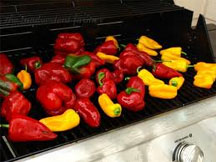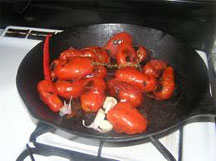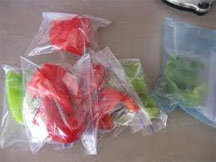Cook'n Basics 101: Roasting and Storing Bell Peppers
By Alice Osborne
 Roasting the ever popular green, red, orange and yellow bell peppers brings out their inherent sweetness, and adds a savoriness and smoky flavor that contributes amazing flavor and body to recipes.
Roasting the ever popular green, red, orange and yellow bell peppers brings out their inherent sweetness, and adds a savoriness and smoky flavor that contributes amazing flavor and body to recipes.
For each of these methods, you may roast the pepper whole, or slice through the pepper lengthwise and flatten it onto the cooking surface. There are 3 basic ways to roast peppers:
 • Oven method: Preheat the broiler. Place the peppers on a baking sheet or oven-proof skillet and place under the broiler until they are browned and blistered. Be sure to check on them often; turn whole peppers occasionally so that all sides are roasted. The more charred they are, the easier they will peel and the more flavorful they will be.
• Oven method: Preheat the broiler. Place the peppers on a baking sheet or oven-proof skillet and place under the broiler until they are browned and blistered. Be sure to check on them often; turn whole peppers occasionally so that all sides are roasted. The more charred they are, the easier they will peel and the more flavorful they will be.
 • Grill method: Lay the flattened or whole peppers directly on the hot grid. If using whole peppers, turn them frequently with tongs so that they blister evenly.
• Grill method: Lay the flattened or whole peppers directly on the hot grid. If using whole peppers, turn them frequently with tongs so that they blister evenly.
 • Stovetop method: Wearing an oven mitt to protect your hands and forearms, and, with tongs or a long-handled fork, hold the whole pepper over the gas flame and turn constantly until the pepper is evenly charred. Or, in a dry cast iron skillet over medium-high heat, "cook" and stir whole peppers or large chunks of peppers until blackened.
• Stovetop method: Wearing an oven mitt to protect your hands and forearms, and, with tongs or a long-handled fork, hold the whole pepper over the gas flame and turn constantly until the pepper is evenly charred. Or, in a dry cast iron skillet over medium-high heat, "cook" and stir whole peppers or large chunks of peppers until blackened.
No matter which method you use, the next step is to transfer the blackened peppers to a paper or plastic bag and seal, or wrap them in foil, and set them aside for at least 15 or 20 minutes to steam. When cooled, the skins can be easily peeled, either with a paring knife or by holding under running water; the skins should peel off easily. Leaving on some of the char is actually tasty and adds to the smoky flavor.
Bell peppers can be frozen for use later. Freezing will cause them to lose their crispness, but they will still be fine for chopping and cooking and adding to chilies, soups, stews, and any other recipe that calls for chopped bell peppers.
 To freeze bell peppers, slice off the tops and remove the seeds and as much membrane as you can. Wash and dry thoroughly. Slice peppers in quarters or sixths, depending on the size of the pepper, and spread pepper pieces on a cookie sheet or baking pan; they should not be touching.
To freeze bell peppers, slice off the tops and remove the seeds and as much membrane as you can. Wash and dry thoroughly. Slice peppers in quarters or sixths, depending on the size of the pepper, and spread pepper pieces on a cookie sheet or baking pan; they should not be touching.
Freeze, then store in a freezer bag in the freezer. They will thaw quickly, so, for cooking, take as many pepper pieces as you need from the bag and return the rest to the freezer. Knowing how to roast and store bell peppers is useful, because they are such health-packed vegetables. Nutritionists have discovered that all peppers, sweet or hot, contain good levels of beta-carotene (related to vitamin A) and vitamin C, the so-called "healing" vitamins.
And speaking of health factors, red bell peppers have twice as much vitamin C and 11 times the beta carotene of green bell peppers. And the hot red peppers have even more beta carotene than sweet peppers or hot green peppers. So let's start roasting the fresh ones and storing them as well, for future use.

